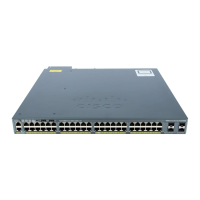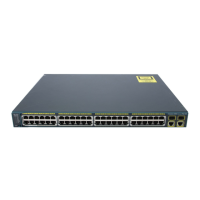IST, CIST, and CST
Unlike PVST+ and Rapid PVST+ in which all the spanning-tree instances are independent, the MSTP establishes
and maintains two types of spanning trees:
•
An internal spanning tree (IST), which is the spanning tree that runs in an MST region.
Within each MST region, the MSTP maintains multiple spanning-tree instances. Instance 0 is a special
instance for a region, known as the internal spanning tree (IST). All other MST instances are numbered
from 1 to 4094.
The IST is the only spanning-tree instance that sends and receives BPDUs. All of the other spanning-tree
instance information is contained in M-records, which are encapsulated within MSTP BPDUs. Because
the MSTP BPDU carries information for all instances, the number of BPDUs that need to be processed
to support multiple spanning-tree instances is significantly reduced.
All MST instances within the same region share the same protocol timers, but each MST instance has
its own topology parameters, such as root switch ID, root path cost, and so forth. By default, all VLANs
are assigned to the IST.
An MST instance is local to the region; for example, MST instance 1 in region A is independent of MST
instance 1 in region B, even if regions A and B are interconnected.
•
A common and internal spanning tree (CIST), which is a collection of the ISTs in each MST region,
and the common spanning tree (CST) that interconnects the MST regions and single spanning trees.
The spanning tree computed in a region appears as a subtree in the CST that encompasses the entire
switched domain. The CIST is formed by the spanning-tree algorithm running among switches that
support the IEEE 802.1w, IEEE 802.1s, and IEEE 802.1D standards. The CIST inside an MST region
is the same as the CST outside a region.
Operations Within an MST Region
The IST connects all the MSTP switches in a region. When the IST converges, the root of the IST becomes
the CIST regional root (called the IST master before the implementation of the IEEE 802.1s standard). It is
the switch within the region with the lowest switch ID and path cost to the CIST root. The CIST regional root
is also the CIST root if there is only one region in the network. If the CIST root is outside the region, one of
the MSTP switches at the boundary of the region is selected as the CIST regional root.
When an MSTP switch initializes, it sends BPDUs claiming itself as the root of the CIST and the CIST regional
root, with both of the path costs to the CIST root and to the CIST regional root set to zero. The switch also
initializes all of its MST instances and claims to be the root for all of them. If the switch receives superior
MST root information (lower switch ID, lower path cost, and so forth) than currently stored for the port, it
relinquishes its claim as the CIST regional root.
During initialization, a region might have many subregions, each with its own CIST regional root. As switches
receive superior IST information, they leave their old subregions and join the new subregion that contains the
true CIST regional root. All subregions shrink except for the one that contains the true CIST regional root.
For correct operation, all switches in the MST region must agree on the same CIST regional root. Therefore,
any two switches in the region only synchronize their port roles for an MST instance if they converge to a
common CIST regional root.
Catalyst 2960-XR Switch Layer 2 Configuration Guide, Cisco IOS Release 15.0(2)EX1
46 OL-29424-01
Configuring Multiple Spanning-Tree Protocol
IST, CIST, and CST

